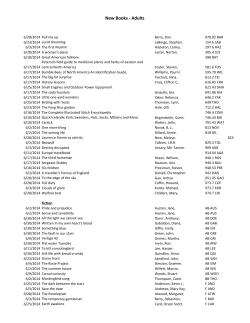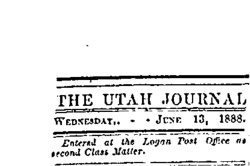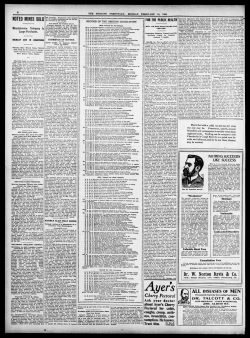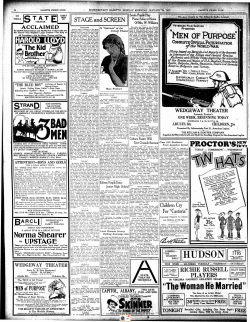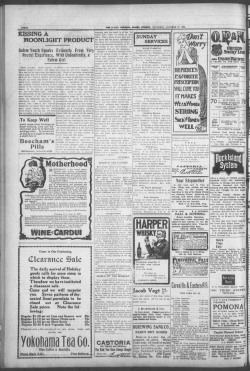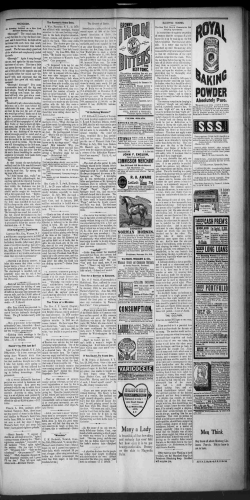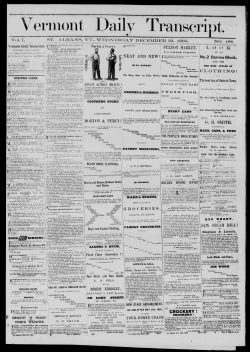
Document 15698
,
THE SECRETARY OF HEAL TH AND HUMAN SERVICES
WAS"ING, ON. r:H;. 2(l?Q,
MEMORAr.'VUM FOR TilE PRESIDENT
FROM:
Vanna E. Sbalala
Y-! ~
Tqday, 10 million--14 percent-of children are uninsured. Ninety percent of all uninsured
children come from working families. Addressing the needs of these children requires a multi
dimcnsionnt approach:
•
increase insurance coverage through Medicaid by reaching those eligible but not enrolled~
•
guarantee twelve month eligibility for those children already enrolled in Medicaid;
•
enhance partnerships with the states' and private sector to help provide insurance for
children; and
•
cxp:md access to community based care.
TilE CHILDREN'S ilEALTil INITIATIVE
Our goal ought to be to improve the insurance and access needs of half of the 10 million
uninsured children. Because there is no single reason why these children are uninsured, no
single solution effectively and efficiently addresses the problem, We also know that enrollment
in insurance docs not ensure access to quality care.
We must fulfil1 the promise of our existing programs and build upon innovative state programs
for uninsured children. We must also allow states and communities to target efforts that best
meet the needs of their children. Our initiative does not include federal subsidies to families with
uninsured children because subsidies are generally costly, may require very high subsidy levels
to attract the currently uninsured into a program, and may inadvertently substitute for employer
subsidized insurance. The overaB investment is almost $12 bHJion over five yeatS. of which $4.7
billion has no scoring implications. The specific provisions and costs for the initiative to address
the im'pOItant health care needs of our nation's children are discussed bciow (see attached chart).
L Medicaid Initiatives
A. Work with sbtes tu fulfiU the promise of Medicaid fur children who are already eligible
under current law. An estimated 3 million children arc currently eligible for Medictlid but not
PAGE 2 - MEMORANDUM FOR THI, PRESIDENT
enrolled. OUf proposal assumes: that up to two-thirds of these children could be enrolled into
Medicaid with enhanced outreach and other efforts targeted at enrolling eligible children, Full
enrollment of all Medicaid eligible individuals has. ~n a challenge since tbe enactment of
Medicaid, and this challenge 'Nill continue as the new welfare refonn bill is impiemenied, We
must:
•
eliminate barriers to effective enrollment of eligible children through managed
care and other Medicaid state programs;
•
streamline eligibility by enhancing the federallstate partnership and providing
best~practice models and other technical assistance to states;
•
increase coordination with other federal programs (day care, Head Start. school
health, community health centers, food stamps, WIC) to improve outreach and
enrollment;
•
increase cQllaboration with foundations and insurers/managed care organizations
to identify innovative ways to improve enrollment;
•
develop public information campaigns to infonn the public about opportunities to
cnroH in Medicaid; and
"
encourage state use of 1115 authority to expand Medicaid coverage and
enrollment.
This illillative will cover an additional two million children. This off~budget proposal will
increase th" cost of the Medicaid baseline by $4.7 billion fur FY 1998-2002.
B. Extend continuous coverage for children age 1 year and older. In 1990, Congress
required continuous eligibility for pregnant women throughout their pregnancy and for three
months postpartum, and for infants through the first 12 months of life, This proposal will
provide stale..,> WitJl the option to allow continuous coverage to children for one year after
eligibility is determined. ()Qing so will guarantee more stable coverage for children and better
continuity of health care services, In addition. it will reduce the administrative burden'on
Medicaid cffieial~, health care providers, social service providers, and families who are required
to reme paperwork for children's eHgibility detemlination.
Tllb, initialive will cover an additional 1.15 million children. This proposal is estimated to cost
$3.5l>illioll for FY 1998-2002.
PAGE 3 - MEMORANDUM FOR THE PRESIDENT
n.
State D,emonstrations
Provide funding for states to support innovative partnerships to insure children not
otherwise qualified to receive Medicaid or employer sponsored benefits, Numerous states
have joined forces with insurers, providers. employers, schools, corporations and others to
develop innovative ways to provide coverage to uninsured children. We ought to provide
matching funds 10 expand the number of states participating in such programs and to increase [he
number of uninsured children who have access to such programs. States will be given wide
latitude in program design but will be required to assure the receipt of critical services including
well-child care and other related services to reduce childhood morbidity and mortality. To
manage costs, programs may include C(}st~sl1aring, managed care, and competitive bidding.
•
Under this program, States will be encouraged to enhance efforts to enroll eligible
children in Medicaid and to expand coverage to other chHdren by creating new
opportunities for insurance coverage thereby creating a seamless system of care for
children in theIr state,
•
For children not otherwise eligible for Medicaid, States will establish income guidelines,
eligibility criteria including limits on access to employer-subsidized insurance, benefits.
copayments an4 premiums up to the fun cost of the program. States may limit coverage
of items and services under the project, but will be required to assure the receipt of
critical services including \vell..child care and other related servkes to reduce morbidity
and mortality.
•
>
Evaluations will be conducted on the effect of these efforts to learn about: (1) access to
health care; (2) changes in health care insurance coverage; (3) costs with respect to health
care:; (4) benefits, premiums and cost sharing.
This initiative will cover an addUionall.S million children per year. It is estimated to cost
$750 million per year, for a total of$3.75 billion for FY 1998·2002.
Ill. Safety Net Initiatives
Enhance access to care through school health centers and consolidated hcalth centcrs
(CHCs). We ,,111 provide increased targeted funding for CHCs to enhance and expand services
to working families and their children, including children enrolled in day care, Head Start
programs, and schools. To strengthen the safety net of community-based providers in urban and
rural areas, these foods will be directOO to communities with high levels of uninsured children,
including EZIEC communities. Funds "Yill be used to increase CHCs capacity to serve uninsured
children and their famines and to better meet the necds of those in their community whosc
insurance coverage IS fragmented or incomplete. In addition 10 increasing their own capacity,
CHCs will serve as a focal J-Klint for marshaling public and private community resources directed
I'AGE 4 -MEMORANDUM FOR
nm PRESIDENT
at child health and. with their partners, taking steps to mesh child health and related services into
local integrated systems that serve children and their families.
We will also provide communities with the option of serving their children through school health
c-cuters. This effort will provide children with comprehensive primary care services including
diagnosis and treatment ofacute and chronic conditions, preventive health services, mental
health services, health education and preventive dental care. School health centers will also be
encouraged to link to other appropriate programs, including Healthy Start, state Maternal and
Child Health, Head Start, Community Schools, and Empowerment ZoneslEnterprisc
Communities, We will encourage programs to develop hilling systems to collect third party
payment and participate in a community~wlde health care delivery system.
This initiative will sen'e an additional 250,000 cllildren per j'ear. The cost of these programs to
the discretionary budget wiil be $25 million per year, for a toral cost of$125 million for the FY
1998-2002,
[ look forward to \'Vorking with you to fulfill our promise to children by making health care more
affordable Dnd accessible through these efforts.
Attachment
Children's Health Care Coverage Initiatives ,,
,
Coverage by
End of2000
Cost in FY 02
5 Year Cost
(FY 98·02)
2 million children
$1.5 billion
$4.7 billion
1.5 million children
$750 million
$3.75 billion
1.25 million
children
SLl billion
$3.5 billion
4.75 million
children
$3.35 billion
$l1.95 billion
1. Expanded Medicaid
Outreach (off.budget)
66(1/0
Suc~c...,s
Ibte
2. Enhanced Siale
Partnerships
3. 12 Month
Option
Totals
~;ligibility
ID:
,,""'0
'*"':
,
FEB 06'97
Ttll:: lteC"ET~I'I¥
or
tll;.ilL .... ANO ~U""/I,'" SERVjr.F.~
..."_1.. 1)"""'", "1':. ufO.
'
TESTIMONY
01'
I,
,I
DONNA E. SHALALA
, SECRETARY
U.S. DEPARTMENT OF HEALTH AND HUMAN SERVT<":F.!O
Ho_ Way. and Moorui Cornmlu..
Wednesday. Fobroaty 12, 1996
Senat~ fJne.nc:c Committee
ThW1lday. February 13, 1996
FEB 06'97
ID:
15:47 NO.014 P.OS I
Mr. Chairmen nno mombo,. of the eomm.ittco: 1'hMk yO\! f.r a1vi.,. mc the
opportunity to testify
10(0)'
about the Pre,ldent" Fiscal Year 1995 Budget proposal.
We in tho Administration Jook forward to wo~kins cloltl)' With you. '" we
frn)Vtt
ThaI gOOQ IdOl 1& "We !he people," and 1< has emboldcne<1 our narlon 10 fl= ..
And (\veroome .. il'Olt challens:e with ~IIIC and unity.
In the 1940", we faee<1 • broken and conquered Europe. but we surnmonod th.
will '" fishl ""d win ....<1 , • .,d tlI. wall. IN", !)'%aMy.
·ID the 50.; we f.ced Ih. I.nihl. ,enuree of polio. But children con1ributed
And We found cn••
And, in the 1960., we foee<1 • Soviet Union ma' bad token the lee<! In me race
tor spooc. But, Pteaident K.ennedy blued 8 ehRllMitr to land an American on the
I
FEB 05'97
ID'
15:47 No,OI4 P,06
I
Wha.t do 41.11 of those triwnphti hove in oDmmon? They onme during ti1'1'\(li of
great social'end political chonge, But with a d«p ..... of urg.ncy, Alnerie..,. put
soal, Today, we muat do
tl:(.
"""e, .
,;
Bce.u"" today,
w. faee enother
g<oot ch4lIe"8': At. timo whOll
we hAYe
fewer r..o~ a population tlllIl Is rapidly aging, end, a d!>fic.lt thlt whll, much
bllll80t Illd trUly retOlD! Medicare, Medicaid, and "",If...., while .1lit I=ploj; our
l'rtlmllleA to the citizens we serve,
!'or more than thirty year., Medtcare has provided. bl..d<.1 of l=JQl .ccUlily
for older Ameriean. and people with disabilities, It has helped 11ft. aenemtlon of
..ruor oitt""". out or po.Otty ..><I Into ~le middle el..., It h.. helped chona- wIw it
""""'" to be old in Alnerioa; what It meen' to be sick ;0 Alnerica; what it mew to
·be dl..bl•• in lImeri.., And It he. ofuon ....,.ed ., • IlwIt line betw."" • lif. of
comlort and good health and a IIf. of '''''ggle and Ulness,
2
. ,
'
ID;
FEB 06'97
15;48 No.OI4 P.O?
Th. Sift that M.dic.... bat given to th... who com. . .fot< u, m\Ut ..
pre=ve<1 for !bop who come after us - tor our children and our gl'llndchildreo, for
every 1I00000allo1\, ThaI is ow: moral rospon&lbllity.
But you and I know thaI Medicare now f.~s a sholt.torm and a long-"'nn
orisis -
Q
miStS tha\ Qcmll.l1;J, action. For neatly four YWI,
we hl"'~ been unable to
come to • consensus On the best way to preserve Medicare and improve II for the
futuro. The l'reaIdent has mad. It .!bar that he wanta 10 work with the Congrcn 10
make Ibi. tha year of bipanl.." IIS"",ment on this vital progtlll'll,
In this budict. tho P:rcaldont has rcached out to the oonSroJSioMJ mejority hy
offcrl"ll a pian to m.et them hall'wl1y, Hi. M.di..... proposol.s wiU oxtend tho life of
tho H,,.pitw Insurance Trust Fund Into 2007, ten y.... from today, I ha,,,, with me
today. letter from the bidtpandent chid actuary of lb. Medicare prognun that verifies
that fllCl. I will be happy
to
submit it for tha record,
The President'. plan oonlribuuos $100 billion to the IIve-yca: b&lwod bUdS¢!,
which COtmpond, to SU8 billion OVl,,! .ix ye.....
And we d~ that by malntaininll • sy,1Iml that guarantees ~I' 10 a defUlCd
of ~rvicc! rathc:t thAn crc4tinJ • <1din¢d contribution 'Per bonofioiu.ry.
3
50'
FEB 05'97
ID:
15:48 No.OI4 P,OS
Thcae proposal, arc nmdc in good fruth ond Me hosed on SOWld poHoy. Th.)'
make un" for bo1h the Medillil. program and its bene!ieiarios, OUr !&vings are
coornhle. There art 110 SimmicieJ. I ilk for yO'Jl tarefW
con,~de:ration
of our
propoaals, and for your pOI'Ine,shlp to enact them.
Bul ModI..... IdQml i, "", and conn.. be almpiy on ........ In DlIlIIber enmching, Tile .\ltIQn& we take this yeer to pr....... the Medicare tru!t fund al"" must ptep4H M~tar. for the future. Not m.my of u, would drive croal oonntry in " tAr
that'a more than 30 years old. Llkew1se. \oVe etm~t mo\'e into the nut ~Clltury with It
health Insttr,ncel""sram bullt in 1%5, ThaI'. why to p!CSCtVe Modh:m, we mull
modemU.o
il,
TIIi, AwdCl.i..uou require. \II to do ,Ix
\hi"",
Third, wo must make Medicare. lIlo,e prudent plll'cllll51lr of health core
Glvjc;.c:a,
Fowth, we must strengthen roar rural health care system.
Fillb. we mu;n protect beneticiari.., 4
'.'"
,'"''''''
"",-'
[D: FEB 06'97
15:49 NO.014 P.09 And sixth. we mutt. continue 10 root out 'Oo'0.3te, Cn:w.d, And obuao. &0 that wo
spond Out hazd-umed
tlix dollars wisely III\d ctlffiivoly,
.,
The Modi""", benefit pockaS' ... ,cmclnc4 relAtively 1I!l<b4ugcd.me. 1965.
But our seienee Iw not. ,'tom Q(:c;adc. of m_.h, we kIIow that pI<venlivc .CIVlc••
not only 0&11 nva money, but also e{Ql gave lives. Now we're p11ttlna onr mnney
o.1!m oW' sel..,.., I.. I am vOl)' pIc"'" by <he hi!""li"'" ,appal" for e'pa"ololl
or lb.
Medlcart benefit p""k~.. The President's plan wiU cover the following:
•
To eliminate economic bani... to lIWlIlI'lOaraphy, wo include 011 annual
I!W'MIOSra!D for Medicaro b""eficiari... W. abt>
""n wAi•• the 1'.,., II
dedUctible 111\4 colnsur"".. for both 5CtCeIlIng .",1 <li.t!!1tJ.Uc mOllwogr.m..
,. To :;avc llvOJ, wo wmt to provide annual lCtocnlng to dctoot signs of colon
cmccr,
•
tie..... better mwgement ot dlll>ew Icod, Wbotlcr 11.,..01,
we
include:
moniloting of blood gll,,,,,.. lovel. end OYIJ>tlUen! self·_eoI tralninR for
dittbetic:!I.
l
FEE 06'97
ID:
•
Tv impcu\lt:: ac(;¢,s to adult
'o'UCCillatiOIlS-
15:49 NO.014 P.l0
and help seniors avoid $(:noUl md
50111etime. deadly illn...... we would illOl'Clsc provider Plyments for ".cci,,,,.
for the hepatitis B '..,cine,
• relative \\1th Alxl\elmer'l disea.., we would provide a new respitb earo
When it come. to heelth care {Of older AmerlcanJ •• or any Americans fot tIIlt
molt<! •• there can bc no confliots betw.." ohcl.. and quality.
w. need both.
W• .,..
proud of our retold of incroaslni choi"" for Medleue benotlclarles WlIlle continuing to
protect tho quolity of • .,•. Sin.. 1993 the nl1mher of he.e!lelarl., in mlllUllled ellre
has increased by 108
pt,,,., and is rioinK
iii.
ro'" ot 80,000 per mOll~", Toru.y,
approlOlNIIOly 13 per.ent of our Med!care beneficlarles •• .waUl S ri!lllion .- arc
om oiled in
-sad •.,. pI.....,
An4 the! numb.. iall1owlollOY 80,000 evezy moot•.
ThD Prciidet'i: budget eontlhuf. thit rrClate~.. by a.dding new choicc. to
Medicate plans. We v,ill inl;)u\l....-: prcfclred. pIovider organiUllioM Ot PPOa. wruoh
offer patients. greater ability 10 choose their doctors and other provider.. And we
,
6
i
I
I
I
FEB 06'97
I D:
l5:~9
NO.OI4 P.ll
PSO., offered by he"lt.l. I\lld physlcla.. under integrated arrongem.entl !hilt we hope
will improvo Olin' and. ndloloe
COlt.
At the ..me tim<, to prOllUl\e real end infolll!Cd choice am.1Ii health plans,
additional enrollment opportunities to subscribe to lIltIllllled tell> and Medl&ep J>l!ns.
To m,,\(e 'UTe thAt ennice ii'l real and thst_benaficlariu Who choose maIlUcd
prohibit MedlllftP losurcn from imposing pr...xi4tlng conditi"" waiting period. whm
I
bonolioi",l.. iDltlolly t/lfoll or any time th.y IMtch pI.",. I. addition, Modi..... will
, I
.,taoli,h amtinuou. Part B enrollment opportunlUe> for
bc:ru:fi.~l.S.
I
QwdIU Prot'iljtlutl
previa,d
quality
to all eltlur.s who rely upon Medltell>. W. wm adopt. new, Int.81",.d
"""'''if''''''' 8JI,lem for M.,I1"", ."d Modlcald.
Traditicnalll', HCFA hAS
W. wiU also collect and db,lo •• more of our swvey dlIIA on ••rtty, quill,!)' of c.....
7
FEB 06'97
10:
and proarorn int.o&rity
~o th~t
15:50 No,Ol4 P.12
citizen!! eM have better compArAtive intonnadon on
pJCU'l~
. and provider.. And we will replace the ","called lO·lO role for manaaed care plans
with l1'lore modern quality. measures, Protectins and improving health. and increlliins
satisfaction wltIt tho
Clll'
received are the goal. ot!li. program,
.;
Pryd.p' PUf5jh,dll1
Finally. Mr. Cha.irman, it II imperative \ha.\
Medi~are
-- which hi the lugcar
pmchnser of health care services in our nation •. be a more prudent purchucr.
tTnfnrtunately. in tnn many c.ases, because of limitatioru in the law Medicare Is now
payinl~
the highest price in the market for certmn drugs, lsb servicc, aod durtlble
medical eQuipment when, givCD the volume of beneficiaries, we should be payina one
of the lowcst. From managed car. premium. to medical devicell. th@ re-fonns.we
propose will make ,ur. that Mecl!care Isn'r payIng rerall wblie ev.ryone .Is. ill paying
wholf5Altl,
The.. proposai, arc sound heallh policy and they require a shared burden.
They will result in
Q
slow.r lat, or srolol.1.h in Medicare spending and ensure tIw
Medioare is paylns a competitive price for the services it buys. The savings that these
proposals generate me spruct
lhey
~lhouJd
be,
011
tbooSt
Acro""
IU'OU
all prnviders or health care: and are focused,.
where growth b the greatest.
8
88
FEE 06'97
10:
15:50 No,OI. P,l3
I. Ma...p. C..., Ilxpert. _
that M.die_', paym.nt m.thDdclogy for
managed care, which was c,eated 1',1982, feaults in $O!ious ovetpllymetlls fo, ..",le,.,
C4l'nO to $Uch a ~olu!iQn with it! 1993 rcviow of the Me41cw.'C Ribk PrugrdIfl. Both
the Physician Payment Review Commission IU1d RCPA SIIldles indlCl\te that Medicare
thould be paying managed oar. pi....... "'to be_ 88 and 90 pet...., of foo,(o,·
aorvlc. ,<»1&, At !be same time, however, pa)'ntents III many smaller. rural plan. life
too low and are
ram"S to attrRCt JT\llch rnftrket In.tetest.
The Presid.ot', budgot also llltiudes reroltllS 1<) move us III a better, more
.otnl"titivo oy_ of perms for managed ....., Throuj;ll our Medi.... Cho~
demon.tration, wo are Ixpclimentlns willi e<>mpetilive bi4<ling and we ar. working on
of new payment. be~inning as early as 2001.
r. tlltb co,q~lQwth, we recommend lhret Intclim and Important chlllljl" in
Medi..... paymentJ for Il'WllIg.a care pl."" Firat we p.!¢po" Ib """" out from the
po.yme:r.t methodology tho.. fund> tho! .:'e iIttondtd to ,",vor the oo.t of direct and
indiact graduate medical education and payments to disprOjlortionato .bare hospitals,
w. will FA)' thell!) fUnds directly 10 hospitals en "-balf of l'tUU'I3.8ed care enroll..,.
ID:
S~ond}
15:51 No,014 P,!4
FEB 06'97
w. wlU grduAlly redU1:t! tho re,gional vatiation In paymentJ to
manl1l;ed care plans and <:reate a payment fioor for plans In rW't.l ca-unties to encourage
enroJln:cnt in mattaged care p:ans-
And; third, we PIOP<>!e to reduce !he M,dicare payment from 9S ~t of the
&vora•• odjutted per capita cost ~ AAPOC -tl) 90 poroent. However, to stve plAn.1 G.
lu!l\c!onr fUIlOun! or time 10 adjust 10 Ih<:se new payment levels, we would not begin
tm. policy until 2000,
Ho.pltal PIYIII'~II. We prop<\se a $ClI., of Medicare hoapitol payme.1
chana" '"
..u.~ tho
pteII'''''' aM t. ,oil... Motk.. ~... Und." tho
PrOJicient 'J \T.ulio~ the hospital payment upOAlO will b. ,edu!:td by one percentage
point every)feaT' from rH:.cal yur lQ9R t'hrnush 2002 to reflect
pruductivilY
IlIJ..t
;ncreAAe:~
in
ho~ite\
emden!;)"
w. 01.. will 1'I0p<\" to ""unto. ttwt.... not dlsclwg• ., ho.pitollwl_ that
result In 6 pattent uslna post acute ""vi~. such as skillet! nursinjj facitity or
reha'biUtltion ho.pittl
~l\{C
for the final
51as,el
of their
tt'6atrnetlt.
nome health eif., Hom<> ll<ilth CIIle Is one of the fastest growilli
,compoae:ntt of MmICilto. Th. e.haro of total Medic.arc Part A s'pondlni dtvoUd to
home health care !las grown from 2.2 percent In 198010 1.5 percent In 1995. In 1984,
10
,
'
FEB 06'97
ID:
1.2 million
MMt~
15:51 No.OI4 P.IS
bonofiohl1'i" uGlId 31 million homt health visiU. Dy 1994, the
number of b••enelu;" bad erown to 3.2 millio. and 1he numbel of visits had
iru:r....d to 209 million.
W. bow tha1 !hi. growth has its !oott in el\anf•• In medical praoUClI. and
tlC'hAoloaY, in tho .)tpandon of th~ bonofit, ud in our c.urront rcimbur,wlOllt 3)'3t-011.4
wh!ch
eM
conttlbulAl '" ovorpaymenl Md abuIIvc pr&etl.... And we know that we
mUJt reduce the 'fat! of growth in Mediea.rt. home het.llh
""ntrol. And, tlllU"
w,,",
apell~ini
and koep it und.r
uur ..ronn. wUl help 11$ do,
(
w. wlU lmm.clt.lAlty ...,;.. our ..... llmlb I••1ltAblW!. • sot of Intuim llmiu
thaI wlll ourb ncossive spending and instit"1I: • now pOI·boneDc!ary payment limit for
./
We willbnplemcnt • new plO.!ptctlve payment system for hom. health scrvl"",
in 1999, Thb sylllem, which Iuu boCl\ ....ommondocl by ."pen. '" control $po.dina.
will recl""e i.oenti... for ovctllUlil:allon.
w. will .limi,,,. perio<l!c interim paymem. for home health agencies.
orli1.ol1y ul&blisheci as tor. incentive for now "ioneio. to so,vo Medic.... pall ......
With 100 new asenolt5 joming Modiollte eooh month) thia. incentlYe:
~100t1)'
b no
long.. necOlIlll)'.
II
I
I D:
FEB 05'97
15:52 No.014 P.16
I
In addition, "'" will pay for home hHlth. ..,,,1••, b••ed on w..... 1M ...,,1.. I.
delivered. fn.nldy, mlIllY egc.cl•• "'" t.e.kl.g .4.l1li'1188 .r. loophol.
bf I.catlng their
billing omces in expe.,! vo urhan are.. to tako advanlage of higher prevailina
loopllole. ,
Along wllh Oll!" strategy to control home heallh spending. we> propose 10
' · _ 1 f1"O," PlUt It. 10 Pad B.
Thi. Is • deficit "."."d ptOjXJ,," and Is not COWIt<d
in our overall Madicorc ...inpnwnber. We would IiInlt PAI\ It. homo health
"""crog. 10 lb. firs' 100 ,;.it. fOllowing. 3-d&y hooplt&! atay which would continue
to be .~overcQ unacr pan A. juit lIS Ibis pan ot the program covers 100 days of ,IdUad
Thi,return Of non·po't.ho'pltlll visits to pm B _. Medi\me policy prior to
1980 •• make. the hom. h.,..lIb
. Pan A !lUll fund
~".roby
\\moe, "'Mllttont v.ir.h .he nriginal i."",. of the
.tw responsibilitY for financing care lllat do...'t belong there.
oignifi.antly .xttndin; 'h' IIf. of tilt _. f\&nd. And. iI .. hi.... !be.. goal,
wIthout subJ""ting bentOclarl.. to Incream In prernllllll! and cOIl-milling.
12
I D:
FEB 06'97
15:52 No.OI4 P.l?
I
I
Ehu:tenci_l')' C.lltfud lurch••ing. To. btcome a more prudent purc~r of
other health service,. oUt pllUl gives the Secrelary payment authorltles to seoure better
deal' for Medic",. and the oltizen. It ,erves. Fromsatting paymenU! b...d on
CQUlpoUUve bidd.illi 10 sclcx;tl.voly pAying ~ll(era of excx:llencc 4 singh:: rate for "ll
,.!'Vi... u90eiated with a specific wagnosis, the.... lin<! our olller purowiag monns
only U'Vive. but tbri1/t), to serve every generation.
heallil c.... in rurn! Am.,i",.
POI ••iWpI., 01:1' phm would ""I'W.u !he Ruxall',lm"'l' C"", Ho.pitol Program
:0
all SO states. It would upd>le the pI)'lIlem for so!e wmmunil)' hospitali, ul'l!)tove
prolPllIIl to provide re50ar~ !D those rural hOspitall !luU n«d It mOrt.
r D:
FEB 06'97
15:52 No.014 P,lS
.I
I
I
we must protect Ollt ~.fioiori••
The I"t
I~
mOl< Ill'" three-roUltha of .enior, !>live Inocmos of ~J.'.LJOO
0, io..,
believe that balance billing limits mu.t protect all benefICiaries. tcgordies. of which
Our pi.... proJ'O'"" Medig.p reform! to WI:Ie portability. protect against p,e
e.xiiUng condition 1imi.U. and provide eqUitable BWi t.ffordahle ptt.mium me,. .
.
It keeps PM tl premiUllli a' 25 tIC"""'l of PIOjIIIn eOllt, Thil diVision of
protec:ted bcnetioiari•• while wurlna that !be COli of Part S i, ahllIed by !h&•• who
For hospital Ou.lplHient !icrvi~.'J, it brlnp the patient oo-tnmltallQ.c: rate down
trom aboiJt 51) porcent to the :W percent charKed foe mQ$t other Pan B serv:iccs.
14
FEB 06'97
I D;
15:53 No.014 P.19
,
And, it ensure, l.h.a1 managed CatO plam pay for Omtribnc-y servico. wh;:rt a
"prudent layPerson" would have roasolll!bly believed they wen: n•••s""l'.
Modernizing Me'io... for the 21" oOl\tW'y 0100 rcqW- ellnl!nt.llng the &.ud
.and .buse thetl'¢bs our heollh ear••ysrem and 0\11' loxp'Yer&
. &10•• I lOOk olliee a
litlle more thAn four year.'
lltMO
tol~"
as~.
I h.ve made this • lop priority by HlUIl8 • polley of
for !mUth ,,,.1;0 freud. And abw;.
Just two y......~o, the Pr••ioont ond I unv.!l.d • pilot project coli,.
"Operation Restore ,tIlOt" to target our anUo!'tIlud etfom 10 fillIrt fraud and abuse in 5
key stat.., W. have .;goifl•• ntly l"""",sed the reso= of our tnopeetor Oellem! and
he••
-aslb,ned our p.YlUent ,.,j,,,,. "';"l! loI:hnulugy to ~ 1'rau!I. and to
,•
~~llt when
It OCC\lH,
And, it', paid off. We Clllmat. lb't every dollar "" invest in our ""Ii·fraud
Mfort Vields 510 dollars in uving. fClJ' tM AmeriCArl people. In faet.. jUtt lui m.o~
fraud by lndep.udent clint.allab" will .at the Medicare proe,ram. over $800 million in
recoveo:nolJ and ponalties by tit• .rut of WtI month.
.1
Il
FEB 06'97
10:
15:53 No.OI4 P.20
I
(?--,-::-\
W. "'tend to m.."wn and inttnslf)' tho...ffortl, I will bo
"'b.mI~to
~-~---
.
Congreu in !he Spring. fraud aud "bus< bllllhat will enable us to 'lrenathon !he
identification lIIld enrollment l'mctdore tn
"."t. 'h" only legitim,t. provide" bill
McdiClU<:. III Ibis bud,e! bill, we "tel.1l< prvv!iiu"" w provont home health agencies
from using. loopoole In the current reirnbummem system
_.rage So
th.. Modi.... doe.
private in."....... W. wOIII~
nOl
to bill " higher urban ralC
pay inappropriately for beneficiaria. covered by
~I
the ,nli.ldclcb,clc exempUoo. for mllllllSed. core
pllllU, _ d I.., r= ornl ",...cd by the CoUil'mlunal
8"'~.1
om"" ...
cOllllid",.blc COJI to the Madl""'" ~rogram. And we orooo.. to reinstate tho
Modi..... Finally, We
"'111ltrcn~.. Our
ombudm!an tIwtloo in the SIOII>, bUild!",
I ead;;e of eldetly volunteertl,
t
MEDICAID
Mr. ChaitnUlll, I'd lib, now, to turn lo'Medlcaid, Thol'resideut', budget
strengthens the Med.i••id proll,"m •••• 1M' "'t <on b.tttr ...ch Ill, vuln....bl.
An,......... It b d••land 10 mye. Olll plllll OOJIUVl> [lie co$li or Medicaid aud Ill.",
new flcxlbUity to the ""tts. without ..mpromiain~ tho FederAl gu,vontee of cover.~
dl..bllltl••.
J6
,
CEB 06'S7
I D:
15:54 No.OI4 2,21
w. ,hould all bo proud that sro~ in Modi";. _din. bA. doollnnd
slgnillcanlly OVI:r tho past two year..
ceo', b.""Une projcet. Ih..·year MOOIcaid
sJ)ending to be mC're thar. SiRn bi11iM 1(\,,-'6 .hlUl J)rojel:'t~d ju.t a year aao for tht aa.rnc
pcriQ4. TIu: Pfosldont'.
i.l\l\lg~ll:llliW:crs
trut1 tho luocoas we have achieved with our
5111111 partners will «)nlinuo.
OUt plllll lives, on nel, aboul $9 bllIlon over fivo ycuc.. 'fol4lmlnas are
.bout $22 billi",,: roughly two.t!>i>'d. Wm ....duetlo. in dillpfoporti...", 01>"",
h~.p11Ol
I>SH I"'Yfll<U"
Wl~
rUllllhly one-thJrd 110m the per "'pita cap. At the sarno
Ilm., Ihe Pxesident', plan In""m SI3 billion in improvolllents to Medicaid lnclwUn.
health inltlalivt. to oxpond -Ill" tot olIUdt'D, chong•• t<l1ost y...... wolf",,, reform
law. IIIId new pollcles to help pCl>Jlle With dj,abllliin return 10 work.
1...1 me lake. minute 10 CX)1lain our per capita cap. Under the President',
prnpo,II!, the Fndero.! goverIIlMnt Will ,onl1n., to ""'lob ...'" Medicald _pending for
each iudlvidultl enrolled" lit thi~ way, thoro bl tlh~lulCl)' no lrn;'CnUVO
deny covllraee 10. ne<dy individual or family,
11 rut ~{,W.l:l:I 1il
ID:
15:54 NO.OI4 P,22 FEE 06'97
Under the p.r t:::lpita "tiPI th.. Ftdorol covertl.lntnt will 05t4bU&h
tl
Oooclinc of
spending ror rour ""'<&0[1.. of beneficiaries: 'll"d, dls.bl,d, adults ill filllllll•• ,.;th
and tho current Fed"",' moldling rate, Tho Federal iOvemment WO'Jld only matel)
~enditll.ros
\41' to
0.
StAte'" toW o1lowoble 1lmit. SUllet!
wm bt.vo flo1tibiHty »u.!O
savings nom one group fo support expenditure, for other groups or to expend benefits
.
Not aU Medicaid .pondi", would be subject to the per esJ>ita esp. Spendilli
l'lI)'lllent, to Indian Ileal\h Scrvi<:< "lid other Indian llealUt provid...., and tlh: Vaccines
for Children program
'WOIlld
he ""eluded Admb:rillll'totive OilS!»
Wl1\tIrl
be ineludcd in
the bu. yOIII' calculation.
Let me be elCI1l': Thi. pOl capita. CAP iJ ncithor Q block ;rant nor n cost shift
10 th. S\a1e$ •• 11' •• ,eo,lbl. way 10 mal<. we that the people who need Medlcald "'"
factOrs cause
Mo~cAid
CfI10)Jl11ent to expand,
81i1~n::~atc :tpt,mdlng
will grow
u".
woll.
This budl/et kcepa our promise of beal!h UlI'C to our mOlt wlnerablt citizen.. but it
II FEE 06'97
10 : 15:55 No.014
P.23
,
[
iIatlt l!1QIbUily
How will we help ,l.te. ke<p 'l'endilli within the.. pot capita limi"? The
i
I
•
Wo would repeal Ibe B~rep emelldmcm f~r hOlPltlis 8IlIInuliina h~m•• IIIId ostabllsh
!
public notice proc... for d<lermlni"lltheae "imbOf_at rattL
I
I
I,
II
,
•
W. allow ,lale' 10 .xpend Medicaid ,ovcrase to new group, ond I. enroll
I
,
btn,fioilri., I. MIWSod ear. witboUI walv.,.,
I•
I
•
We .limin.... tM requirement for "".l·bes'" payments for health clinlcs ond
I
adversely affeclod by thi! policy.
•
W. repl"". the 7S!2S enrollment compos!llon rule for MedlCJId mllMged taro
~l.M
•
wid,
new qu.lil)' data stMdard<.
W. ilive SlIlle. tho oplion of cxtendlng Medicaid he.lth core 8IlIIIong lomt
cmploymenl CoteO by Amerl""", with dlsab!lllle"
19
I
. I:
FEB 06'97
I D:
•
We l!l1iminate the detlilletf reqltlr~.menti for
stittI'!
15:55 No.814 P.24
claimro ·proceHing and
Iml paymeD! Mom
In oddilioll to 0", PCI ""piw .ap will! .nh",ced . _ flex!bll!l}', feaeral DSH
payments win be reduced aCId retargered to safety net hoJPitili and other essential
community providers,
MeriiCRid fl$H srendiIli doubled <ach yelU' from 1988 to 1993. Although Ilrl.
"'P!d glowth Ilru< slowed .. lhank. 10 blpartlll8ll law. enacted In 1991 and 1993 to
.
pl... sc:!ctOl' limite on growth in tho DSH proar&n •• tod.y'. DSH program i. still too
large ""d is often incomimntIy distributed among Statco and is not always focusoO on
safet), net providm.
20
'.
1
FEB 06'97
I D:
15:55 NO.OI4 P.2S
ClIY.rlll. Child ....
Mr,
Chairm~.
I lenou' that All of tho members ofthb Committee agt•• that th.
tr"!!cu), of som. 10 million Amellcan chlldfen Without htlllh lruIurance demand.
bipo.rtinn action. The VO$t majority of these chil<lren 11.0 In' r.mlli~ WIlen: p"",nlS
work .bcnland ploy
~y ~,.
Nlo..
,We helieve that fit\latiOll it unacceptable (Of
mould bove
&
great nation. No wOfldns pa.rtrnt
'0 IIv. wid, UIO Ii>IIl' that hi. or hor ohildren Will become sick or hurt on.
day .. 0Ild there will b. nowhm to tllk. them 10 .... the paln.
Our ,.lli. to oul the number of uninsure:l ehildl<n by up to 5 million 01ICf the
m:xt five ),eu..
tho!.
And, the President',l budset take. important
step$. to
help
\II
do just
..'
FiI'!tt we wiU itvc mte.s the option to allow 12. ,month! of continuoUl McdtO-N.ci
oovc:qe ior all eblldfen who are eligible. By S!l>pplns 1ho churning of childfen in
and
OU\
of Medicaid, we can provide ,uble (!OVWI.Se fo.: children and bMttr continuity
of ",rvice•. W. estimate .his cbanio wm help ••• million cIllldl<n lIMually.
Sc¢ond, tM DcpnrtmMt 'Will work (10801)" v.ith the states to ecroll at le.curt 1.6
muli.n oftbelliUmatod three million ohil<ll'cn who are eligible tor Medicaid today but
21
'1'
r0 :
FEE 06'97
1~:56
No,014 P,26
WOO, TM a va:l'imy Clf rl'MOn'•. ~ n(;t enrolled. W. IH committed 10 working in a
bl}llUtl~llua.un1:J
with \he nation's govunors to make thl! 11 reality.
ThUd. wo oxpect S..... to ooroll &II 04didonAl 2'0,000 l.w-'noomo ohlldren In
...h of tho,next lOur Y.'" ., pBll of tho phased-i. Ol<paruic. of ooveI'fl!!' to children
h.1Wten the «gea of 14 and 18 wer eW1'ifnt
~w.
Fon the Pre,iden,', Healthy Worklns F.",IIi... in;til'!ive, "'hkh l'lovidbs up
to: aix months of pmnium C8siJtan~ to wor.kcn ~on jobs, it Ixpcetcd. to II1d
ano1ilcr 700,000 ohlldren to the priWl....clOr InsutOllOC ron..
And Ill\h, we will mzl<e available to rho,
innovatltve
pro~
.we, $7S0 million annually
desig:ncd to p~chase pdvate iNUfAnCe for an
e.~timRtM
II> $UI1pon
one
million ~n.!Urc4 ehil4ron in famlllcs that rCCitiVQ neithe1, M~uid OO( l;mployct
'JlO!l!Ored in.IlI'IIll:',
Mr, Chalrman. Ie, ma say that w< view the.. propooal, as • package, They
will diamalically leduce the number of onin'UTe<! ohild... In Amerl••, ,h....by
impll)ving their health a.nd their p~t$'
pi~
of mind. .And,
~hoy
wut ~oak
Ilil
aftor••bl. Medicaid program thBllWfills the promiiOS we have made to our most
VluMrnbla citizen,_
FEB 06'97
I D;
15:56 No.OI4 P.27
I,
Welfare
It', the ••m. wuy ..1th ",olfare ref""", When the Pr.'!~nt ,tBnt<! tho PmoltAl
lUos,POnsibilityand Work Oppommity Reccn.!i",,'"" Act ~f 1996, hf, marl. it el.... 1h.t
<hi. ".., thO bosll1llh1i -- not the end •• of welf..-. rcf~Jm. Ho tIlWo il c1." thot we
all lIs'I' • rosponlibility to come together rmd make this law work •• especially for OUt
('hild~n,
And. he made it alta: that this wu u opportUnity for
\l.5
to i:l'eatc:
Q
wclflU'Q
.ySlOlll thOl requlre, work, promo"" ptltCntal ....pontlblUty, aru! protectl Cblldren.
Pm proucl of tho pwgrcu we'vc made
alroacly givon 43 .\BIOI the flexibility th=Y
tOFthCl.
With
OI.1!
wAiver.s. wo've
"".d II> tcst Umovative welflU'e str.teai...
I'atemlty .".bllobm••", hnvollOno up SO por"""t 1Iiltc. 1992, In 1996, we 0011_.
record of over $12 blliion :n chtld IIlll'pot1 poyntonw. And tile ",ugb neW provisiollA
in tho welfAre law ale projC'lCted to increase child
ilUppllrt c:ollectin"~
hy lin Additional
$24 billion over 10 ynn.
of our ooonOO'f, ",elfare roll, have gone down )1
2.~
million .. thoI'. more than Ib
percent since tho President took office. Movina people fYnm welfate to work, tMbiing
wlllch oil oj' US have alWAY' "lIreod. W. are committed 10 «>mbinlng all of the
leJ1netliihfr. talenf And
l~Outc,(l'
pastiMe to tmplel'nent the new welfare law,
23
I
I
,
15:57 NO.OI4 P.28
FEB 06'97
I D:
Let me hriefly give. you a pro81t"U report on our
~mpl.mcntation
of the new
Ternpor",y A.,i,"",.. for Needy famille' (1ANF) P<OflWll· Althc>ullh aWlos Itave
until lui) 1997 to Irnpl,ment lb. TANF
~roi'am,
w. hove e.l.reody give. Ihe _
ligbt to 35 It.... (Ill of 1129/97) t. beiill d••ir «furm,. lliI5 luis provided gUldllllte
In<l1cBllng lbllt Stale, have Ilexlb!lily in c!csigning their TANF progranu, but At lb.
At 1ho Foderallev,!' we are challenzlng St,,.. to ,,_[o:m the
th. t)'$ttm from
Q.
VOl')'
culture or
welfdtc prO,",," to a work program, W" ~uu.sllauoch a national
oftollln eve,y ~'ta.. ami ew,!')' OOIMLWllty to make surt ther. are jobs for peopl.
III"'"
boy. opportunities not only !IJ lind jobs. but to keep 1hom,
CrOAting these opportun.{t(c:. wUl \rOO:
A
ronunhmeut from
MihC:J$
IU1d labor.
And. it wiU tab \hi! bipmiWl ConSl1lf:sionailipirit tlurt broupt u, tbi& fu - and Ul1.lat
continue to carry WI dOWll the road to sueom,
work Initiotive. The
l'f~re
individuals
Pmi~nt'. ~!Oposal
f~r
will help States nnd cities create ne... Jobs,
thtm. o.nd provide employerc with inccntivoa to ertate now job.
24 FEB 06'97
I D:
15:57 No.G14 P.29
i"he Pretidenl's y.-elfut to work Invc$tments inoludQ c 53 billion Jobj.
Cludl.n~.
<le,lgned t(: tnoVe • mflllon of the hardest to ,mploy welfar. reciDients into
lBlltini jobs by the year 2000. It expand1i
I$CUU
to cndit and enhanc., employer
inClonuvet to help IonS-term wolforc: rcclplel1b.
nua ill; an exeidn; lnlti&uv. in whioh lJWony
depa!1menlS of Treuwy,
La~or,
dcpcrtmen~
and .,CIlt.io! , .. the
Transportation, HUV, and others - havejolnod
Uliother to further the Ptc,I\:ident'.,1irrn Ct'lmnUtment to ma.k.e wtlfart morm. a roaUty.
At HHS, we will b. usintl all tho m••", al .UI w.p.SIIl 4> help ftuntll.. go to work
arul beoomc self,sufficient,
A. Ilndl"""'" earllet, the hailmllIK of thI. welillre law!. the
b~a<I
n..lbility it
gives lItatcs to design innovAtive fcfo!mJl thAt "rltlrt.9S their uniqut' ~ha1lenges. W.
confi~::.nt thM
StA\OJ will use thia
cOllsld~rAble il(;W nCAibn~l)'
InlUative. 10 strengthen their foe"" on work"" well.
We Will be monitorin, Slale porfonnlllll:C
them.
~ngly.
at.
und the President's new
;
and. PUlIIUlUlI to the stalll!<. l1Illking
W. will h. irlentlfying end .."dying llul hlab perform." e.od tho
low ptrfomlCill tro.r;kiug
~h11d.
P4>VOl\1, w«1
pru'{id~ iUl overall
lellislation', imp.act on ehildt•• and famili...
,
assessmen.t ot tho
FEB 06'9 7
ID:
We will look closely at how.,.... comply with so,"" key
roqulremt:n(~,
15:57 No,014 P.30
statuto!")'
!nclu4.ing chU(l support enforcement, work par"Jclpltion tates.
malnteruul"" of effort, and data roporting.
W. IIlso will O!sume major now rerponsibililitl for compiling and
di;..runfllttns infofDtlrlion. AI the number of options continue! tc grow••tAm will
net;! better Information '~OUt Loe'. option" aru! the \:CI\lltIlS "'ill need better
information to "'CS8 how effectively f.d...1fl1nrl. are ,IUd
I know that several members of CQni"1S have "'~1I111fd • wait·and·.ee
.pproach to tho new weii'm I)'''.m, thty ml.. thot .,ote implemcntolion Mould b.
"""fully rovlewed bera" Wldort4klng ""Iio, poUt)' change. to tho r A.' IF prollfllm.
Oui DOJ)8l'tlI1eO! IUIII proposed. numl>.r of ,..,hnleAI .nd ,<>nfonninS ohMie. to tho
TANP PNJltGm tht.t 1believe maint4in the spirit and Wlcu\ of iUi pol1cles.
Our AdmitUsttaUon bellevos: that w~lmr4; J'<lfonn hca oJways bi;or. ,. .. MG m\t6t
lllwoy, remoin ••• blPil111""" issue. But, j..t as we cam. toper to _
worl< ond
""pOIlllibllll)' the law of the IAlld, we helie•• It " time '" """" tOll"thet "l!ldn to
insure t.hA.t the
~torpic"
of wCllw'C! reform n:::wwn,
work for everyono who is able to work,
26 tI
n!w effort destgned to tlnd
FEB 06'97
15:58 No.014 P.31
I
Tho President', FY 1998 budllet lUW' good on hi. pronUs< to correct
cllildJren, and the disabled. who
eanMt
, NGA resolution lut wtlck. agNod ~
work, We
WQ
lite
pleaqetf
that
1M i¢'Vtmor•• in a niua.t not balance tbe b,",geL on tho becks of Sun.. or l~gollmmlgr..ts,
0", budS'" would ...."',. 0 ..my JlO1 of 551 and Food SIIll'Ill'B for loglll
imml$,lant children lind forl.gIII itnmlirortts who he.om. «.=Iy di..b1od. It would
Uli'tan•• aflerlhey ent., the U,S,
~
'0 tha1 they have cllOuth time to overcome the
hsrd&hlll" they 1m.. r.cod and to become ..If •.mcl.n~ And it would deloy the FOO<!
Stomp
bOIl Oll k~w
immiirant, by 1 month•.
Ovorall, our proJ"03o.ls
i'!1'QDlth~n
our eonunitment to
11 Ue'W ~clttu-c
system
officlah and '''!lmrl,., bc.neLts ta those who c.an·t work ~ partiouUaiy ohildf¢n and the
before US; reforming our wolfar. sysrom tolletha1.
Mr. U\lIlrmon, the bodget I have dlscuHed \Odoy di.",ds tired old ,.,lutlo..
27
,
FEB 06'97
I D:
15:58 NO,Q14 P,32 I
I
I
I
Now we- muwt a.ct upon it.
lug_Iller 10 prOtACt the health of itS elllZcN III the 21" c<nlUty,
Tho am~r is up to
UlI.
Thl1rik. you.
7.8
•
'.
FOR RELEASE UPON DELIVERY
THURSDAY, JUNE 23, 1994
*REMARKS BY DONNA E. SHALALA SECRETARY OF HEALTH AND HUMAN SERVICES NATIoNAL PRESS CLUll WASHINGTON, D.C. "THIS TEXT IS THE BASIS OF SECRETARY SHALALA' S ORAL REMARKS. IT SHOULD BE USED WITH THE UNDERSTANDING THAT SOME MATERIAL lIAY BE ADDED OR OMITTED DUllING PRESENTATION. ,
•
1
Thank you Gil Klein, for that gracious introduction.
ltd also like to thank Eleanor Clift, for organizing this
luncheon. and giving me this opportunity to talK with you about
the important issue of welfare reform.
I am really here to talk about the future of our
country~
The future of our country is a young couple in Cleveland,
forced to separate because the husband's meager income
disqualifies them from the welfare assistance they desperately
need.
The future of our country is a battered wife, huddled in an
emergency shelter in Miami with her children -- facing the choice
between ,.relfare and an abusive husband.
The future of our country is three children in New York who
rarely see their father and know that he doesn1t pay child
support.
The future of our country is a 15-year-old girl in Omaha,
who is a victim of rape.
The future of our country is a young mother in Racine who
had a good paying job that didn't come with health benefits.
When her baby qot sick, she had to swallow her pride and go
on welfat'e to get Medicaid"
And the future of our country is a 13-year-old girl in
chicago who is being pressured by her 20-y8ar~old so-called
"boyfrier!d" to throw a.way her future to satisfy his desire for
sex.
The future of our country is full of despair for too many
Americans -- and full of hope for too faw.
In Kansas City, Yola.nda Magee has hope and a future.
The former welfare mother stood with the President in her
hometown last Tuesday and told the country she believes welfare
should bE~1 in her own words, "a stepping stone" -- not a way of
life.
And the future of our country is also the young people I met
at an alternative school in Los Angeles and at the D.C. Street
Academy, whose graduation I attended last week.
These schools provide a second chance at education for
students who have dropped out or been kicked out of school.
•
At the D.C* Street Academy, the student graduation speaker was a 20-year-old woman who described her determination to succeed because of the example she wants to set for her 2-year old daughter and 4-year-old son. That courageous young American and all the graduates I met that night represent the meaning of somethinq the President has said many times: "We
don~t
have a person to waste in this country6 tf
These students worked hard.
They earned their diplomas.
The road behind them was rocky, but they didn't give up on
themselves. Nor did their teachers give up on them -- and We
shouldntt either.
America is a country that does not give up on her people.
We are a country that believes in giving people a way up and
a second chance -- while demanding responsibility and
accountability in return.
That is the essence of the Administration bill introduced
two days ago by House and Senate leaders and Committee Chairs,
led by Senator Daniel Patrick Moynihan -- one of the natlonts
most brilliant and visionary thinkers on soc~al policy.
Last week, Newt Gingrich said about our bill that we
promised a Ferrari and delivered a Yugo.
He's wrong on both eounts.
The Work and Responsibility Act of 1994 is a distinctly
American family car:
Solid in desiqn.
Economical in cost.
And well-equipped to begin a challenqing journey to move
millions of Americans from dependenoe to independence.
There's room enough inside this welfare
proposal , to carry
,
the whole family:
Democrats and Republicans; liberals, moderates and
conservatives; businesses and schools; children and their young
parents -- and above all, working Americans.
3
In fact, if you take a look ~t most of the legislation up on
the Hill, you will find some striking similarities -- proof that
the consensus for welfare reform transcends party lines.
Both the President's plan and the major Republican plan
emphasize the values of work and responsibility_
80th make public assistance a transitional proqram leading to mandatory work. Both emphasize parental responsibility and delaying sexual
activity -- especially for teens.
Both provide funding for education, training, child care and
job creation.
And both recognize that it will require an investment -- of
time -- and money -- to move young mothers toward self
SUfficiency.
And let me say to those extr~ist critics out there -- some
of whom have apparently not even bothered to read our plan -
-- We believe the Work and Responsibility Act represents an
historic moment -- a monumental Shift in this country's approach
to lifting people out of poverty~
Empower America didn't even get it half right.
The bedrock assumption of our legislation is that work
organizes and gives dignity and meaning to our lives.
Our bill is based on the American values of work and
responsibility -- which is exactly what 161 Republicans -- not
extremists -- call for in their own welfare bill.
And welre sending the strongest possible message to young
women that they must to stay'in school, postpone preqnancy -
delay having children until they are fully capable of raising
them.
Either the extremists didn't read our plan -- or they don't
want to understand it.
Under our plant it will be clear to all teenagers -- young
men and young women -- that having a child is an immense
responsibility -- not an easy route to independence.
And from the very moment a young woman walks into a welfare
office, she will understand that she is now in a transitional
program leading to work9
4
After an assessment of her skills and training; she will
design a_personal employability plan -- a work and training
agreement -- designed to move her into a real job as quickly as
possible.
She will get help with job training, job search, and child
support, with the clear understanding that. as soon as possible,
she must work -- preferably in the private sector.
And we expect that many recipients will be working well
before they hit the two-year time limit.
aut, after two years, if she has not found a job, cash
assistance will end, and she will be required to take a job in
our subsidized WORK
program~
And here, there's no question that our bill is tougher and
smarter than the Republican alternatives.
Because, unlike traditional "workfare", there's real
accountability here.
In t:raditional workfare, the welfare check is still the
bottom line because, it's so time consuminq, difficult and
bureaucratic to sanction someone who fails to meet their
responsibility.
In our WORK program, reCipients will get jobs in the private
sector whenever possible -- and in the public sector only when
necessary.
They will only be paid for hours worked.
paycheck -- not a welfare check~
And they'll get a
Wages -- not Workfare.
But let me also
be
clear about this:
We passionately reject the
abandonDIEmt of all help
~o
~ore
radical calls for
young mothers in need.
Charles Murray and Empower America may have gotten the
problem right, but their solution is all wrong.
Thelr draconian approach would "end welfare, period tl -
abolishinq all forms of public assistance to young, unmarried
parents, and relegating their children to orphanages.
Institutions that nineteenth century social critics like
Charles Ilickens exposed as abject failures.
Their proposal sounds almost surreal.
5
A 1994 version of Jonathan Swift's RA Modest Proposal P -
which arc;rued that the best way to deal with food shortages and
overpopulation was to eat the children of the poor.
But Empower America isn't being satirical.
They are seriously proposing that the best way to deal with
ttmPorar"z' dependency is to render people
l2ernanentJ.~
destitute.
That's not something you'll find in The Book of Virtues.
Let me repeat: abandonment of responsibility -- by
qovernment or by citizens ...- is UnAmerican~
It's wrong -- and it won't work -- to cut off all benefits
to poarl single women and their children ~- even when they play
by the rules and are willing to take part in education and job
training.
It's wronq -- and it won't work -- to create a generation of
children who will grow up on the streets, and who will have no
reason -- ZERO -- to believe in the ideals of this country -
including the most basic ideal that hard work will,he rewarded.
It's wrong -- and it won't work -- for Murray and his
disciple!':, to advocate letting unmarried fathers off the hook
absolving them of any responsibility to support the children they
helped bring into this world.
to give up on parenthood
It'E! wrong -- and it won't work
and bring back those nineteenth-century orphanages.
But that's just what Murray and Empower America would do.
That's why I think the bill supported by some extremists who
embrace their approach could be labeled, "The Give Up on Young
Americans Act of 1994."
seventy peroent of Americans, in a recent poll have
responded with a resounding NO to the Empower Arllerica approach.
I
While more than 90 percent in another poll agreed with the
President's approach emphasizing work and responsibility.
And this support crosses all demographic lines;
African Americans, Hispanics, Whites •• Asian Americans
From the gulf coast, to the midwest -
from South Central L.A. to Bangor, Maine
6
across all income levels -
a.nd across a broad ideological spectrum.
There is wide agreement that our plan takes the right stand
toward truly ending welfare as we know it.
Under the President's plan, we're dramatically shifting the focus of the welfare system from simply handing out welfare checks tc:) preparing people to earn paychecks. Our push-pull approach combines supports, sanctions, and
economic incentives to honor people who work hard and play by the
rules -- and penalize those who don't.
We believe that by strengthening supports for working
Americans -- by expanding the Earned Income Tax Credit, by
requirin9 work, by 9Uaranteeing health care with every job, and
by providing child care, we will provide a solid platfo~ for
millions of Americans who are struggling to make the leap from
welfare to work.
And we will make a
difference~
We're not just tinkering at the margins.
This is a big effort -- that promises real, measurable
results.
By the year 2000, one million people who would otherwise be
on welfare, either will be completely off or working their way to
independence.
But our plan is as tough as it is far-sighted.
As Senator Moynihan, has been telling us for more than 30
years, teen pregnancy, out-of-wedlock births, and single-parent
families are enormous social tragedies.
Unlike those on the left and right who simply want to,
continue a sterile debate, we want to meet the Senatorls
challenge to address these tragedies.
We believe that holding teenage parents responsible for
support of their children makes more sense than simply cutting
off their benefits or maintaining the status quo.
We're talking about fathers as well as mothers -- because
both parents are equally responsible.
Our plan provides time-limited benefits for teenage
mothers -- but only if they meet several conditions:
7
They must liv·e at home with their parents or a responsible adult. They must identify their child's father.
They must stay in school or participate in job training_
They must attend parentinq olasses, if they need them.
And we are not letting young fathers off the hook either.
Our plan goes further than any Presidential initiative ever
proposed in expecting fathers to support their children.
Our plan says to Deadbeat Oads! if you Ire not providing for
your children, we'll garnish your wages, suspend your drivers and
professional licenses; track you across state lines~ and if
necessary make you work off what you owe~
And we know that there are men out there -- many of them
young men -- who want to do the right thing and support their
kids, but can't because of lack of skills or chronic
unemployment~
That's why, in addition to toughening child support
enforcement, our plan allows states to extend supports such as
counseling, job training, and parenting classes to unmarried,
low-income fathers too -- as long as they are taking
responsibility for their children.
These policy changes reflect our belief that, given a little
help, most men and women will rise to honor their
responsibilities as parents.
Butt in addition to requiring responsibility, our plan also
places primary emphasis on the prevention of teenage preqnancy.
The link between teen pregnancy and poverty is cleara
Approximately 80 percent of the children born to teen
parents who dropped out of high school and did not marry are
poor.
In contrast, only S percent of children born to married high
school graduates aged 20 or older are poor.
We know that it will take comprehensive, community-based
approache,s to empower young people to delay sexual activity and
parenthood until they are emotionally and financially ready~ And
we're absolutely committed to promoting abstinence-based programs
in the schools as a key to preventing teen pregnancy.
•
•
B
For ·all teenaqers -- boys and girls -- we believe that there's a crucial link between abstinence and aspiration~ This fact really struck home for me last week when I read the article in a national magazine about Katherine Mims, a 21
year-old sophomore at Hunter College, the CUNY college I headed for eight, years in the 1980s~ The article described a remarkable partnership we developed while I was there that has given dozens of teens something to say YES to while helping them delay pregnancy. Katherine -- who was raised on welfare -- was offered a
full scholarship to Hunter College.
The deal was she had to participate in the Family Life and
Sex Education Program of the New York Children·s Aid Society -
and she had to not qet pregnant.
Today, Katherine supports herself by working full-time for
the program as she continues to march toward her 0011ege de9ree.
We believe that the Work and Responsibility Act of 1994 will
help millions of other American. like Katherine Mims break the
cycle of dependency and finally begin to build lives of
productivity and independence.
As the President has said, "This is not a partisan issue,
this is an American issue~"
There is a broad consensus on our approach to welfare
reform.
And any attempts to derail it have to be viewed more as
posturing than as substance.
It is a gross injustice to,the American people that -
simply for political reasons -- a small group of ultra-r19htists
would oppose a bold, centrist bill that, is based on values they
espoused for many years.
At the same time, any embrace of the status quo is also an
injustiec because it is clear to the overwhelming majority of
the American people, that welfare as we know it has failed.
j
America's children -- increasingly our poorest citizens
deserve a chance to 9row up to opportunity, not poverty and
hopelessness.
And the debate in Congress should be conducted with their
futures in mind.
J
~
•
9
The debate in Congress should be conducted in the true spirit of bi-partisanship that has been so elusive in the past. We are one country -- not two parties.
All of us must work t0gether to put our people back to work
and to revitalize our basic values: work and responsibility.
opportunIty and family.
Thank you.
© Copyright 2025
